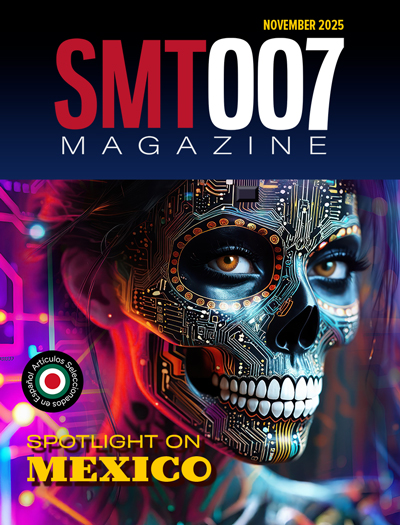-

- News
- Books
Featured Books
- smt007 Magazine
Latest Issues
Current Issue
Spotlight on Mexico
Mexico isn’t just part of the electronics manufacturing conversation—it’s leading it. From growing investments to cross-border collaborations, Mexico is fast becoming the center of electronics in North America. This issue includes bilingual content, with all feature articles available in both English and Spanish.

Production Software Integration
EMS companies need advanced software systems to thrive and compete. But these systems require significant effort to integrate and deploy. What is the reality, and how can we make it easier for everyone?

Spotlight on India
We invite you on a virtual tour of India’s thriving ecosystem, guided by the Global Electronics Association’s India office staff, who share their insights into the region’s growth and opportunities.
- Articles
Article Highlights
- Columns
- Links
- Media kit
||| MENU - smt007 Magazine
IPC-J-STD-001: The State of the Standard
November 10, 2021 | Jonathon Vermillion, Ball AerospaceEstimated reading time: 2 minutes
One of the most frequent questions I was asked during the last year was about the biggest changes in revision H of the IPC J-STD-001 Requirements for Soldered Electrical and Electronic Assemblies. The J-STD-001 is the material and process requirements used for manufacturing of electronic assemblies.
The latest revision of the J-Standard was mostly completed online with working group meetings. There were more than 1,700 comments submitted to the H revision, including those from the IPC-A-610 Task Group. While some of these were editorial or overcome by events (OBE), there were still quite a few for a mostly all volunteer task group. We achieved the first draft industry review (FDIR) milestone right after IPC APEX EXPO 2020. One month later, we were all caught in the grips of a lockdown and a pandemic, and we planned to transition to online meetings. There was similar push at our day jobs, which made sense. It worked out well; we split up comments and worked as a team. I researched the technical comments, while co-chairperson Milea Kammer dispositioned the editorials. Technical comments must go to the task group for resolution, as it takes a two-thirds group vote to close a comment. Sometimes we have comments that can’t be accepted or dismissed. In that case, we might assign a working group to the issue. We usually find that when we can’t reach consensus, we either don’t have enough information or we haven’t talked it out enough.
In 2015, it was recognized that the long-standing cleanliness provisions of J-STD-001 Section 8 were no longer adequate for modern electronics and that a new approach was needed. A group of cleaning subject matter experts (SMEs), dubbed the Rhino team, were assembled to create the new protocol. This group of SMEs was led by Doug Pauls of Collins Aerospace, a long-time leader in cleaning materials and processes in the IPC. He said “tiger” was overused and he always had a fondness for the rhino, a particular animal of the Serengeti. The team was tasked to come up with a better way of characterizing acceptable/unacceptable residues on electronic assemblies and the effects of the residues, and to address both clean and no-clean electronics. This SME team (or A-Team) met two to three times a month over the course of three years, resulting in the approach published in J-STD-001, Revision G, Amendment 1. Because this was such a dramatic change from what manufacturers were used to, the Rhino team also generated a detailed white paper, explaining the changes. IPC-WP-019A was the resulting document. When IPC-J-STD-001 went to Revision H, WP-019 (Rev B) was also revised to keep the language current. In addition, several members of the Rhino team have hosted half-day and full-day professional development (PD) course to help people understand the changes.
To read this entire article, which appeared in the November 2021 issue of SMT007 Magazine, click here.


